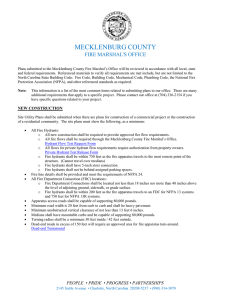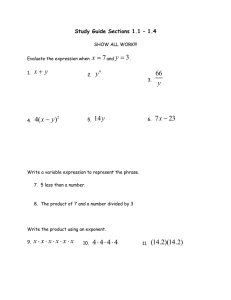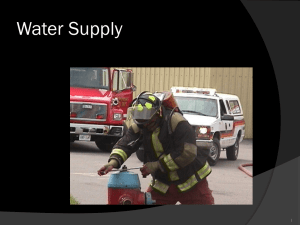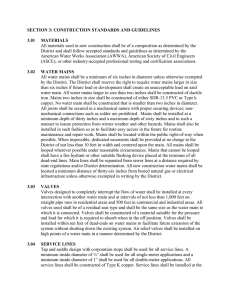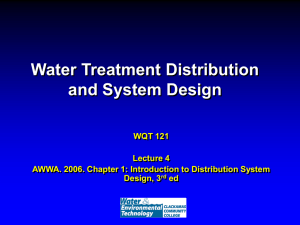water system requirements
advertisement
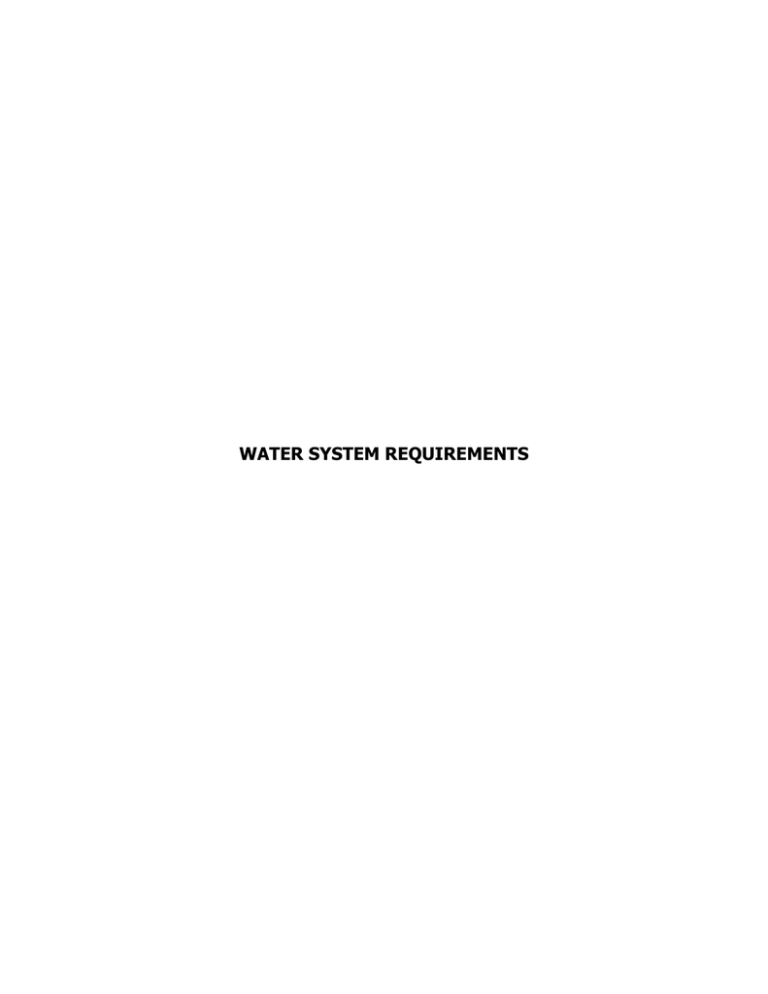
WATER SYSTEM REQUIREMENTS WATER SYSTEM REQUIREMENTS I. II. III. GENERAL: A. Design criteria for all water systems shall comply with Texas Commission on Environmental Quality (TCEQ) Chapter 290 (Rules and Regulations for Public Water Systems), latest revision. B. Permits from agencies other than the town must be submitted through the town. C. The Engineer shall include on the design plans a summary of pipe sizes, pipe materials, and joint materials. D. Profile elevations shall be provided for mains twelve-inch (12”) in diameter and larger. Eight-inch (8”) mains may be required to be profiled by the Public Works Department. E. Where applicable, line sizes shall comply with the Water Distribution System Master Plan or subsequent revisions. F. Water mains shall be sized and extended through the limits of a development to serve adjacent properties. In phased construction of thoroughfares, the water main shall be extended the entire length of the thoroughfare being constructed. WATER MAIN LOCATION: A. Water mains in right-of-way shall be installed in the street at five feet (5’) from the face of curb on the opposite side of the wastewater main, or otherwise as directed by the Public Works Department. B. Water mains shall be located at least five feet (5’) from any tree, unless approved by the Public Works Department. C. Water mains installed under creeks or ditches shall be protected by concrete encasement a minimum of ten feet (10’) past the toe of the embankment on each side or otherwise as directed by the Public Works Department. D. Water mains crossing under storm sewers shall have a minimum of eighteen inches (18”) clearance below storm sewers. One segment of the water pipe shall be equidistant from the center line of the storm sewer. E. Where a new water main crosses over a new non-pressure rated wastewater main or lateral, one segment of the water main shall be centered over the sanitary sewer main and there shall be a minimum of twenty-four inches (24”) of clearance or otherwise as governed by TCEQ Chapter 290 requirements. F. Where a new water main crosses under a new non-pressure rated wastewater main or lateral, the water main shall be encased in high density steel pipe in accordance with the Town of Addison Standard Construction Details and there shall be a minimum of six inches (6”) of clearance or otherwise as governed by TCEQ Chapter 290 requirements. WATER MAIN SIZING: A. All water mains shall be a minimum of eight inches (8”) in diameter or otherwise as shown on the Water Master Plan. 1 B. Six-inch (6”) fire hydrant leads shall not exceed one hundred feet (100’) unless otherwise allowed by the Public Works Department. C. Water mains shall be extended to provide water to adjacent property as directed by the Public Works Department. D. Dead end mains are not permitted unless otherwise allowed by the Public Works Department. For dead end mains allowed by the Public Works Department, a fire hydrant shall be installed at the end of the main for use by the Public Works Department. IV. V. WATER MAIN MATERIALS: A. All water mains twelve-inch (12”) in diameter and smaller shall be AWWA C-900 PVC Pressure pipe with cast iron O.D. or when pipe penetrates meter vault walls it shall be ductile iron. Pipe joints shall be rubber ring and integral thickened bell, assembled with a factory supplied lubricant. Water mains shall have a minimum class rating of 165-psi for domestic use and a minimum class rating of 235-psi for fire line and hydrant lead applications. Joint material for PVC shall conform to ASTM F471. B. All mains crossing under existing roadway must be installed by bore or otherwise as approved by the Public Works Department. Rust resistant steel casing minimum one-fourth-inch (1/4”) thick shall be used with Raci patented casing spacers, or approved equal. No wood skids will be allowed. C. All fittings shall be ductile iron, full bodied, mechanical joint type with restraining glands and have a minimum rated working pressure of 250 psi and be manufactured in the United States. Fittings shall be wrapped with 8-mil poly prior to backfill. Compact fittings shall not be permitted unless otherwise allowed by the Public Works Department. D. All valves and fittings shall have concrete thrust blocks installed. Thrust blocking shall be minimum 3000 psi concrete and be able to withstand a minimum 200 psi test pressure. E. All mains supplying fire sprinkler systems outside of utility easements shall be minimum 200 psi working pressure and U.L. listed. F. Connections where the existing main is one or more sizes larger than the proposed main can be made with a full body stainless steel tapping sleeve and valve. In order to maintain a manageable parts inventory and working knowledge of tapping sleeve and valves, the following tapping sleeves are approved: Mueller, Ford and Smith Blair. G. Connections to existing lines twenty-inch (20”) or larger are not permitted unless allowed by the Public Works Department. WATER MAIN CONSTRUCTION: A. Line and grade stakes for construction of all water mains and services shall be furnished by the developer’s Engineer or their designated representative. Property lines and corners must be properly staked to ensure correct alignment. The Town will not be liable for improper alignment or delay of any kind caused by improper or inadequate surveys by the developer or by interference of other utilities. B. Waterlines shall be tested both bacteriologically and hydrostatically. Water mains shall be hydrostatically tested at 150 psi for four (4) hours. Fire lines shall be hydrostatically tested at 200 psi for two (2) hours. C. All bleeder lines shall be removed upon completion of testing by removing the corporation stop and installing a brass plug in the tapping saddle. 2 VI. TRENCH REQUIREMENTS: A. Embedment shall comply with NCTCOG Class “B+” embedment. A layer of geo-textile fabric shall be placed on top of the stone prior to the placement of the select or granular material. Finish backfill shall be native soil free of all rocks and clods greater than three inches (3”) in diameter, compacted in six-inch (6”) maximum loose lifts to a minimum of 95% Standard Proctor Density at zero to three percent (3%) of optimum moisture. Trenches under pavement may be backfilled with flowable fill with a minimum compressive strength of 400psi to the level indicated by the pavement thickness with the approval of the Public Works Department. A batch design shall be submitted for any flowable fill used within the public rights-of-way. B. Locator tape shall be placed on top of the sand embedment. C. The minimum cover to the top of the pipe shall be as follows: 1. Lines larger than sixteen-inch (16”) shall have a minimum of six feet (6’) of cover. 2. Sixteen-inch (16”) mains shall have a minimum cover of five feet (5’). 3. Twelve-inch (12”) and smaller mains shall have a minimum cover of four feet (4’). VII. THRUST BLOCK REQUIREMENTS: A. Concrete for blocking shall be class “B” B. Pour concrete for block against undisturbed earth. C. All anchor fittings to be concrete against thrust blocked. All ductile cast iron fittings and/or pipe to be polywrapped prior to pouring the thrust block. D. Concrete shall not extend beyond joints. VIII. VALVES: A. Valves sixteen-inch (16”) and under will be Resilient Seat Gate Valves (RSGV). All gate valves shall be of the resilient wedge type conforming AWWA C509, Standard for Resilient Seated Gate Valves, in its most current revision. In addition, all valves shall include the following design criteria: 1. In order to maintain a manageable parts inventory and working knowledge of valves, the following resilient seated gate valves are approved: Mueller A2360, AFC 2500 and AVK Series 25. 2. Wedge shall be cast or ductile iron, fully encapsulated in synthetic rubber. 3. Wedge rubber shall be molded in place and permanently bonded to the iron without screws, rivets or similar fasteners. 4. Wedge shall seat against seating surfaces arranged symmetrically about the centerline of the operating stem, so that seating is equally effective regardless of the direction of pressure imbalance across the wedge. 5. Valves for underground installations shall be non-rising stem type, opening counter-clockwise by means of a two-inch (2”) square operating nut. Valves for installation in a vault shall be of the 3 rising stem type opening counter-clockwise by means of a hand wheel. The word “OPEN” and an arrow indicating direction to open shall be cast in the metal of the nut or hand wheel. 6. Stem shall be sealed by at least two O-rings. All stem seals shall be replaceable with the valve fully open and while subject to full rated pressure. 7. All nuts and bolts shall be stainless steel. 8. The waterway shall be smooth and shall have no depressions or cavities in the seat area where foreign material can lodge and prevent closure. The waterway shall be large enough to accept full size tapping cutter without damaging the interior of the valve. 9. The valve body and bonnet shall be epoxy coated, inside and out, with fusion-bonded epoxy. Coating shall conform to AWWA C550-90, Standard for Protective Interior Coatings for Valves and Hydrants. IX. B. Valves shall be placed in such a manner as to require preferably two (2), but not more than three (3) valves to shut down each segment, or as may be required to prevent shutting off more than one fire hydrant/service or no more than fifteen (15) residences in a single family residential district. C. Valves shall be placed at or near the ends of mains in such a manner that a shut down can be made for a future main extension without causing loss of service on the existing main. A minimum of twenty feet (20’) of main shall be installed past the valve. D. Where four-inch (4”) or larger fire lines are connected to town water lines, valves shall be installed on each side of the connection and on the fire line. E. Valve boxes shall be provided for buried valves. These boxes shall be three (3) piece screw type cast iron of the extension type and shall be Mueller No. H-10360, Bass & Hayes 3 piece adjustable screw type, or East Jordan Iron Works 8560 with 6800 lid, or approved equal. The three (3) pieces shall consist of the top section, bottom section and cover. F. Valve boxes located outside of paved areas require a reinforced concrete block twenty-four-inch by twenty-four-inch by six-inch (24” x 24” x 6”) flush with finished grade. G. All valves shall be marked with a saw or stamp on the curb or pavement with a “V”. The “V” shall point to the location of the valve as follows: If the valve is in the paving, the “V” shall be marked upright; if the valve is outside the paving, the “V” shall be marked upside down. H. Valves over five feet (5’) deep will require extensions, or otherwise as directed by the Public Works Department. FIRE HYDRANTS: All fire hydrants installed for use in the Town of Addison shall meet or exceed AWWA Standard C502-85 or the latest revision thereof. Fire hydrants shall have a 5¼” minimum valve opening. Rated working pressure shall be at least 150psi; test pressure shall be 300psi and hydrant capable of flowing 1000gpm (Class A). All hydrants shall be manufactured in the United States and shall be manufacture’s best grade. Hydrant shall be warranted by the manufacturer for a minimum of 5 years. In addition, all hydrants shall include the following design criteria: A. General Design 1. In order to maintain a manageable parts inventory and working knowledge of fire hydrants, the 4 following hydrants are approved: Mueller Super Centurion and AVK Series 27 Nostalgic Style. 2. All fire hydrants shall be of the three-way style consisting of two (2) opposing hose nozzles separated by one (1) pumper nozzle, dry barrel type. 3. A clearly visible arrow and the word “OPEN” shall be cast in relief on the top of the fire hydrant. The fire hydrant shall be opened by turning the operating nut in a counter-clockwise direction. 4. The operating nut shall be all bronze, one piece, pentagon measuring 1¼” from point to flat and at least 1¼” in height. 5. The manufacturer’s name, size of main valve and year of manufacture shall be cast in relief on the upper barrel section and clearly visible to aid in the identification of repair parts. 6. Lower barrel shall have ground line markings cast in relief and clearly visible approximately twoinches (2”) below the flange to aid in proper installation. 7. The fire hydrant shall be a “traffic model” with the upper and lower barrels joined at approximately two-inches (2”) above ground line by a separate and breakable swivel flange providing for 360 degree rotation of upper barrel for proper nozzle facing. The “traffic model” safety flange shall employ unweakened stainless steel hex head bolts (AWWA C502, Sec. 3.2.17) and fasteners of sufficient strength to bear all test and operating pressures. The stem shall be two-piece, not less than 1¼” in diameter (excluding threading or machined areas) and shall be connected by a breakable stem coupling. The weakened portion of the coupling shall be below the coupling pins to eliminate failure due to excessive torque. All screws, pins, bolts or fasteners used in conjunction with the coupling shall be stainless steel. The coupling shall be made of stainless steel to eliminate failure due to electrolysis and corrosion. The coupling joint shall be located below the top of the lower barrel to prevent vehicle wheel or other forces being applied to stem, which would open the valve mechanism. 8. Shoe and barrel castings shall be fabricated of ASTM A-126, Class B gray iron or ductile iron ASTM A-536, but no combination thereof, assuring uniform strength of all cast components. B. Site Requirements 1. Fire Hydrants shall be placed at a maximum spacing of three-hundred feet (300’) along all streets and fire lanes. 2. Fire hydrant leads shall have a bury depth of between four feet (4’) and five feet (5’). 3. Valves shall be placed on all fire hydrant leads. It shall be a mechanical joint and flanged tee with a flanged end to mechanical joint gate valve so that the valve is anchored to the main. All mechanical joints shall use restraining glands. 4. Fire hydrants shall be installed so the breakaway point will be no less than two inches (2”) and no greater than six inches (6”) above the final grade elevation. 5. Fire hydrants shall be located a minimum of three feet (3’) and a maximum of six feet (6’) from the fire lane or roadway, based on the location of the sidewalk. The fire hydrant should generally not be located in the sidewalk. When possible, the fire hydrant should be kept at least eighteen inches (18”) from any sidewalks. 6. All fire hydrants placed on private property shall be adequately protected as approved by the Public Works Department and the Fire Department and shall be in easements. All such 5 protection shall be the responsibility of the landowner on which the said fire hydrant is placed. 7. All fire hydrants shall be installed so that the steamer connection will face the fire lane or street or as directed by the Fire Department and/or the Public Works Department. 8. A three foot (3’) wide non-erodible surface shall be placed around the fire hydrant and from the fire hydrant to the curb directly in front of the pumper nozzle. 9. Fire hydrants shall be located at street or fire lane intersections, when feasible. When placed at intersections or access drives to parking lots, fire hydrants shall be placed so that no part of the fire truck will block the intersection or parking lot access when connections to the fire hydrant are made. 10. Fire hydrants required by this article and located on private property shall be accessible to the Fire Department at all times. 11. A Blue Stimsonite, Fire-Lite reflector model 88-SSA (or approved other) shall be placed just off center of the street or fire lane opposite fire hydrants. At intersections, reflectors shall be placed on both roadways opposite fire hydrant. 12. In non-residential developments an eight-inch (8”) lead will be required on all fire hydrants that are located more than one hundred feet (100’) from the looped main. 13. The fire hydrant shall be set on the projection of the property line when possible. 14. Fire hydrants shall not be installed within nine feet (9’) vertically or horizontally of any wastewater main, wastewater lateral, or wastewater service line regardless of construction. C. Operation 1. Hose nozzles shall be 2½”, pumper nozzle shall be four-inch (4”) pumper gauge (40480). Chains between the fire hydrant and nozzle caps shall be omitted. Nozzle section shall allow for field replacement of damage threads without special tools, excavation or disturbing the ground joint line. Nozzles shall be fastened by mechanical means and secured to prevent nozzles from turning or backing out. Nozzle caps shall be provided with 1¼” pentagon nuts at least 1¼” in height, a recess provided at the inner end of thread for gasket retention. Centerline of lowest nozzle shall be at least eighteen-inches (18”) above ground line. 2. Main valve closure shall be compression type, opening against line pressure and closing with the pressure. Main valve shall be 5¼” in diameter. A bronze seat ring shall thread into a bronze drain ring (or shoe bushing). This bronze shall be low-zinc (less than 16%) to minimize galvanic corrosion. Design shall allow for removal of seat, drain valve mechanism, internal rod and all working parts through the top of the hydrant without disturbing the ground line joint or the nozzle section of the hydrant. 3. Lubrication of the upper stem threads, operating nut threads, and upper and lower thrust collar bearing surfaces and O-ring stem seals shall be done automatically as the hydrant is opened. Lubricant shall be low viscosity, non-toxic, FDA approved oil. Oil reservoirs shall be separated from the waterway by two (2) O-rings. 4. The drain system shall consist of two (2) valves feeding two (2) external discharges. Drain system shall be so designed as to provide for both automatic and intentional force flushing at full line pressure. Drain valve mechanism and outlet shall be all bronze. 6 5. The interior surfaces of the shoe and lower main valve components shall be epoxy coated in compliance with AWWA Standard C-550. The shoe and lower barrel shall be connected by stainless steel bolts, nuts and fasteners of sufficient size and strength to bear all pressures and forces that the hydrant is subject to, including corrosion, for its warranted life. D. Painting and Delivery 1. Hydrants shall be delivered with two (2) coats of primer on upper barrel (AWWA C-502 Sec. 4.2.3). Interior and exterior shall be painted as in AWWA C-502 Sec. 4, excluding the interior of shoe which shall be painted be as noted in Sec. 2.F. 2. Hydrants shall be complete in all details when supplied. Due and customary care shall be used in preparation for shipment to eliminate damage in handling or transit. Hydrants must be drained and completely closed before shipment. 3. Manufacturer shall supply an Affidavit of Compliance verifying that the hydrant and all materials used in its construction conform to the applicable requirements of the most current form of AWWA C502 and these supplementary specification, that all specified tests have been performed and that all test requirements have been met. X. WATER SERVICES: The service curb stop shall be installed at a depth of eight-inches (8”) to twelve inches (12”) below finished grade, usually in advance of paving. After paving, the contractor shall furnish and install the meter box. The meter box is to be set within the right of way or utility easement line at or near the center of the front of the lot to be served. No meter box shall be installed in an area paved for vehicular traffic and/or parking spaces. Minimum requirements for water services: A. General Design 1. All Meters shall meet or exceed the American Water Works Association Standard C707-R92 for Encoder-Type Remote-Registration systems for Cold Water Meters when equipped with an open architecture radio MIU. 2. Allowable tap and meter sizes are as follows: ¾”, 1”, 1½”, 2”, 4”, 6”, 8”, 10” and 12”. All other sizes are prohibited unless specifically approved by the Public Works Department. Taps and meters shall be the same size unless specifically waived by the Public Works Department. 3. Water meter boxes shall be provided for each service as per the Town of Addison Standard Details. Water meter boxes for meters two inches (2”) and smaller shall have a minimum depth of eighteen inches (18”) and have four inches (4”) to six inches (6”) of grade 4 crushed stone and four inches (4”) to six inches (6”) of free airspace placed under the meter inside the box. Meter boxes and openings shall be large enough to allow access to and operation of all meter nuts/flanges/bolts and the curb stop without obstruction. Meters larger than two inches (2”) are required to be in a concrete vault. Openings below the finished grade in the meter box shall be permanently closed. 4. The size of services for apartments, condominiums, or multi-family services will depend on the number of units served with a minimum of one (1) meter per building. 5. All service taps on existing water mains shall be inspected and approved by the Public Works Department. 6. Multiple meters manifold in parallel are not permitted. In such instances a single larger meter 7 shall be selected. 7. Bullhead connections are not permitted unless approved by the Public Works Department. 8. Domestic and fire service connections on fire hydrant leads or dead end mains shall not be permitted. 9. Meters shall be set horizontally level in all directions. 10. All irrigation meters, fire meters and meters four inches (4”) or larger in size shall be turbine meters. All domestic meters two inches (2”) or smaller in size shall be positive displacement meters, unless otherwise approved by the Public Works Department. B. Water Services two inches (2”) and smaller shall include the following design criteria: 1. The service saddle shall be of one of the following: a. Double-strap bronze with CC. (AWWA taper) threads: Mueller #BR2B, Ford #202B or McDonald #3825. Tap shall be set at 45° of vertical on the main line. b. Mueller Servi-Seal™ style 502, 504, 506 or 508; seven inch (7”) minimum length. c. Ford Style FS303-CC. 2. Corporation stop with AWWA taper threads (CC) by conductive compression connection. Following is a list of approved corporation stops: a. For ¾” use Mueller H-15008, Ford F1000-G or McDonald 4701BT. b. For 1” use Mueller H-15008, Ford F1000-G or McDonald 4701BT. c. For 1½” use Mueller H-15013, Ford FB1000-G or McDonald 4701T. d. For 2” use Mueller B25008, Ford FB1000-G or McDonald 4701T. 3. 90° angle curb stop with lock-wing. Following is a list of approved curb stops: a. For ¾” and 1” use Mueller H-14258 or B24258, Ford KV43-332W-G or KV43-444W-G and McDonald 4646BT or 4606BT. b. For 1½” and 2” use Mueller H-14277, Ford FV43-666W-G or FV43-777W-G and McDonald 4646BT or 4606BT. 4. All companion flanges shall be elliptical brass and all bolts & nuts shall be grade 316 stainless steel, 5/8-11 x 2½” hex head. 5. The tapping saddle and corporation stop must be poly-wrapped (8 mil) and hand backfilled with sand to a depth of twelve inches (12”). Additional backfill may be placed by mechanical equipment and may consist of material free of rocks and clods exceeding three inches (3”) in diameter. The Public Works Department shall inspect the installation of the polywrap and initial backfill. 6. Piping shall be type “K” copper, continuous from the corporation to the curb stop and completely embedded in sand for a distance of six inches (6”) in all directions. 8 7. In-line curb-stops, meter yokes/setters, and/or meter risers are not permitted unless approved by the Public Works Department. 8. Gate valves on the inlet side of the meter are strictly prohibited. XI. WATER METERS All meters with top and bottom plates shall be made of bronze and equipped with electronic absolute encoded registers, programmed to read in thousand gallon increments, and equipped with touch-pad readers. A. Domestic (potable) Use: 1. All 1.5” and smaller devices with flow capabilities ≤160 g.p.m. shall employ a nutating disc. Disc meters shall be Hersey 400 Series IIS™ or 500 Series IIS™, Sensus SRII, or Neptune T10. 2. All 2” and larger commercial unit applications for domestic use having flow demands greater than 160 g.p.m. shall employ a Hersey MVR™ turbine meter. B. Irrigation services of any size shall employ a Hersey MVR™ turbine meter. C. Fire Service: 1. Less than or equal to 2” meters shall be a Hersey MVR™ turbine meter. 2. Greater than 2” shall be either a Double Check Detector Assembly, or a Reduced Pressure Zone Detector Assembly. These assemblies shall be approved by the University of Southern California Foundation for Cross Connection Control and Hydraulic Research (USC-FCCCHR), and installed in USC approved orientations and clearances. The bypass or detector shall meet the requirement of the 1.5” or smaller domestic use written above. XII. WATER EASEMENTS: The following minimum width exclusive water easements are required when facilities are not located within public rights-of-way or easements: A. Water mains eight inches (8”) or larger in diameter shall be located within the center of a minimum fifteen-foot (15’) water easement. Fire lines smaller than eight inches (8”) in diameter shall be located within the center of a minimum ten-foot (10’) water easement. B. In residential developments, water mains shall not cross residential lots unless specifically approved by the Public Works Department, in which case the easement shall be located within a single lot. C. Fire hydrants located outside of public rights-of-way shall be centered in a ten-foot by ten-foot (10’ x 10’) water easement. D. Two-inch (2”) and smaller meters serving multi-family residential and non-residential developments shall be set in a minimum five-foot by five-foot (5’ x 5’) water easement or in the right-of-way. E. Meters larger than two inches (2”) shall be in a minimum ten-foot by ten-foot (10’ x 10’) water easement if not located within the public right-of-way. 9
